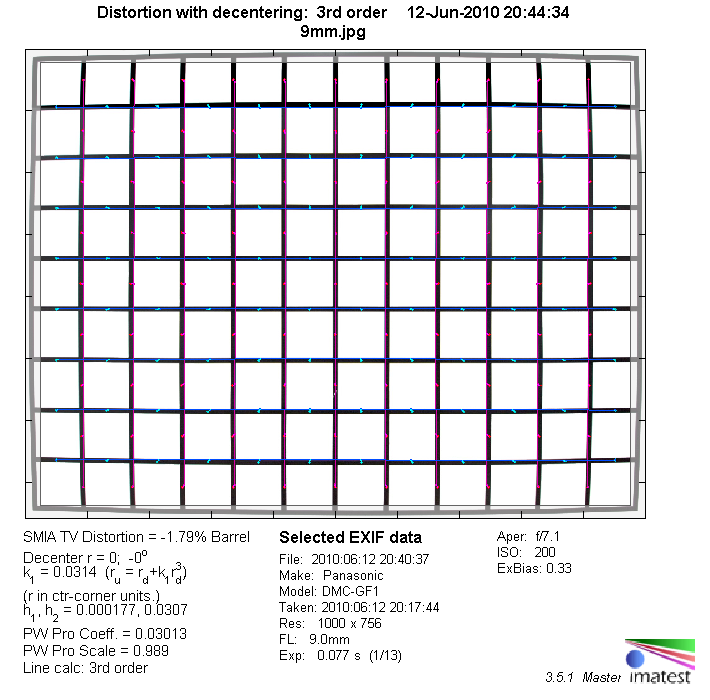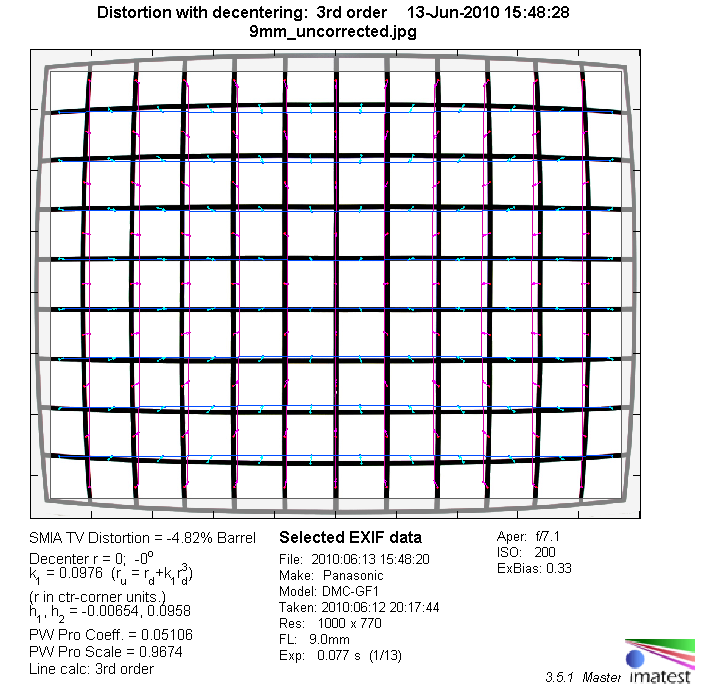|
Olympus M.Zuiko Digital 9-18mm f/4-5.6 ED - Review / Test Report - Analysis |
|
Lens Reviews -
(Micro-)Four-Thirds
|
|
Page 2 of 3

Distortion
The image distortion produced by micro 4/3 images is auto-corrected either directly in the camera (JPEGs) or in most RAW-converters. The "exposed" distortion is therefore very moderate especially for such an ultra-wide zoom lens. They range from a moderate 1.8% barrel distortion at 9mm and slight barrel distortion at 12mm to basically no distortion at 18mm. This is usually nothing to worry about from a field perspective.
|
Move the mouse cursor over the focal length text marks below to observe the respective distortion
|
| 9mm |
12mm |
18mm |
|

|
However, the situation changes significantly when working without auto-correction (e.g. via RawTherapee) which gives an insight about the native distortion characteristic. The amount of barrel distortion is indeed very extreme at 9mm (4.8%) altough the problem eases towards the long end of the range.

Vignetting
The lens shows a slightly stronger light fall-off at 9mm @ f/4 (0.7EV) but other than that users can enjoy basically vignetting-free images (from a field perspective).
The native (uncorrected) vignetting is also somewhat higher with a peak of ~1EV at 9mm @ f/4. This is actually about average for an ultra-wide lens so the lens is not purposely under-designed in order to save costs here.
MTF (resolution)
The resolution figures of the M.Zuiko are very decentfor an ultra wide angle zoom lens. At the 9mm and 12mm setting the center resolution is very high from f/4 to f/8. The borders/corners follow on a very good level at these apertures. The global quality starts to decrease at f/8 and f/11 should be avoided due to the inherent diffraction effects. The quality decreases slightly across the board when moving towards the 18mm setting but they don't fall apart for sure. All-in-all a very harmonious performance.
Please note that four-thirds cameras have a different diffraction characteristic than APS-C or full format cameras. The real-world sweet spot, the point of highest resolution, is generally around f/4, maybe a little less. Therefore it's hardly possible to improve the performance by stopping down when using (such) slow speed lenses. Remember that f/8 on a four-thirds camera is comparable to f/16 on a full format camera so f/5.6 is actually already well sufficient to achieve a maximum amount of depth-of-field at conventional focus distances.
Please note that the MTF results are not directly comparable across the different systems!
Below is a simplified summary of the formal findings. The chart shows line widths per picture height (LW/PH) which can be taken as a measure for sharpness.
If you want to know more about the MTF50 figures you may check out the corresponding Imatest Explanations
Chromatic Aberrations (CAs)
Lateral CAs (color shadows at the image borders) are not auto-corrected to date but Olympus is working on a (desirable) solution here. However, the native CA characteristic is actually very decent at well below 1px on the average at the image corners. This is hardly something to worry about.
|